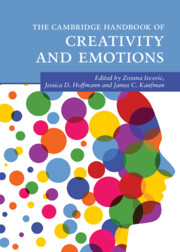Book contents
- The Cambridge Handbook of Creativity and Emotions
- Cambridge Handbooks in Psychology
- The Cambridge Handbook of Creativity and Emotions
- Copyright page
- Dedications
- Contents
- Figures
- Tables
- Contributors
- Acknowledgments
- Creativity and Emotions
- Part I Methods in the Study of Creativity and Emotions
- Part II The Development of Creativity
- Part III Emotions and the Creative Person
- Part IV Emotions and Creative Products
- Part V Emotions and Creativity at School and Work
- 24 Anxiety, Fear of Failure, and Creativity
- 25 Peers, Affect, and Creativity at School
- 26 Creative Curricular Experiences
- 27 Organizational Affective Climate and Creativity at Work
- 28 Group Affect and Creativity
- 29 Psychological Safety and Creativity
- 30 Leadership, Creativity, and Emotions
- 31 A Multilevel Model of Emotions and Creativity in Organizations
- 32 Creativity and Emotion
- Index
- References
24 - Anxiety, Fear of Failure, and Creativity
from Part V - Emotions and Creativity at School and Work
Published online by Cambridge University Press: 16 February 2023
- The Cambridge Handbook of Creativity and Emotions
- Cambridge Handbooks in Psychology
- The Cambridge Handbook of Creativity and Emotions
- Copyright page
- Dedications
- Contents
- Figures
- Tables
- Contributors
- Acknowledgments
- Creativity and Emotions
- Part I Methods in the Study of Creativity and Emotions
- Part II The Development of Creativity
- Part III Emotions and the Creative Person
- Part IV Emotions and Creative Products
- Part V Emotions and Creativity at School and Work
- 24 Anxiety, Fear of Failure, and Creativity
- 25 Peers, Affect, and Creativity at School
- 26 Creative Curricular Experiences
- 27 Organizational Affective Climate and Creativity at Work
- 28 Group Affect and Creativity
- 29 Psychological Safety and Creativity
- 30 Leadership, Creativity, and Emotions
- 31 A Multilevel Model of Emotions and Creativity in Organizations
- 32 Creativity and Emotion
- Index
- References
Summary
At the heart of creativity is the unknown and the new, the breaking from conventions and conformity, and the challenging of existing norms and ideas. Those essential parts of creativity come with the threat of failure, rejection, embarrassment, exclusion, and non-conformity. However, the experience and intensity of this threat and the resulting anxiety and fear is likely different for each of us. So, where does fear of failure, and the anxiety it may produce, fit into the creative process? Are fear and anxiety barriers we should try to remove to become more creative? Are they catalysts for creative risk-taking and the enhanced alertness that help us recognize an opportunity for innovation, invention, and growth? This chapter explores features of creativity and the creative process that relate to the affective states of anxiety and fear of failure with the goal to illustrate the research on how these states can be managed, and even leveraged, to enhance creativity.
- Type
- Chapter
- Information
- The Cambridge Handbook of Creativity and Emotions , pp. 461 - 478Publisher: Cambridge University PressPrint publication year: 2023



